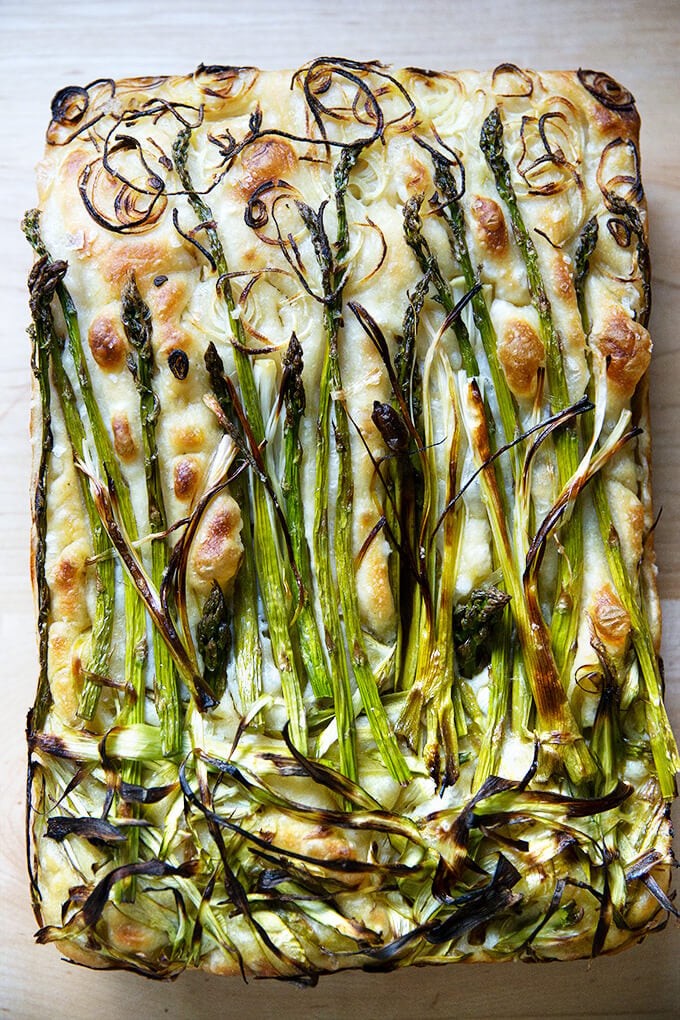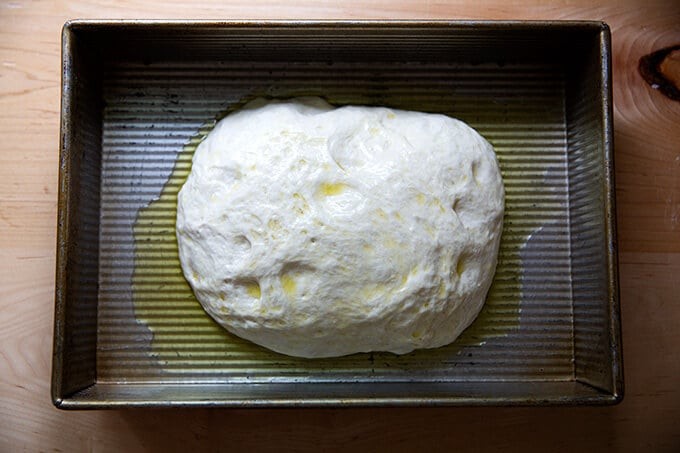What Is Focaccia Bread? It’s a flatbread that’s versatile, flavorful, and surprisingly easy to make. Join WHAT.EDU.VN as we explore everything about focaccia, from its origins to its many delicious variations. Learn how simple ingredients and techniques can create a culinary masterpiece, perfect for any occasion. Explore related terms like pizza dough, peasant bread, and olive oil bread for a deeper understanding.
1. Unveiling the Essence: What is Focaccia Bread?
Focaccia bread is an oven-baked Italian flatbread, similar in style and texture to pizza dough. It’s typically seasoned with olive oil, salt, and sometimes herbs. The beauty of focaccia lies in its simplicity and versatility. It’s a blank canvas for culinary creativity, offering endless possibilities for toppings and flavor combinations. Think of rosemary focaccia, sun-dried tomato focaccia, or even focaccia topped with caramelized onions.
Focaccia has ancient roots, tracing back to the Etruscans in ancient Italy long before the Romans. The word “focaccia” itself comes from the Latin “focus,” meaning “hearth” or “center,” reflecting its origin as a bread baked in the ashes of a fire. Over centuries, this simple bread has evolved into a beloved staple of Italian cuisine.
2. Why Focaccia Bread is a Baker’s Best Friend
Focaccia is more than just a delicious bread; it’s also a baker’s dream. Here’s why:
- Simplicity: Focaccia recipes often require minimal ingredients and straightforward techniques, making them accessible to beginner bakers.
- Versatility: As mentioned, focaccia is incredibly versatile. It can be enjoyed plain, used for sandwiches, or topped with a wide array of ingredients.
- Forgiveness: Unlike some finicky breads, focaccia is quite forgiving. Minor variations in ingredient amounts or baking time won’t necessarily ruin the final product.
- Impressive Results: Despite its simplicity, focaccia offers impressive results. Its airy texture, flavorful crust, and beautiful appearance make it a crowd-pleaser.
3. The Magic Behind the Texture: High Hydration and Fermentation
The signature texture of focaccia, characterized by its light, airy crumb and distinctive air pockets, is achieved through two key elements:
- High Hydration Dough: Focaccia dough has a high proportion of water relative to flour. This high hydration creates a light, open structure within the bread.
- Long, Slow Fermentation: Allowing the dough to ferment slowly, often in the refrigerator for an extended period, develops flavor and strengthens the gluten, resulting in those desirable air pockets.
These processes help to create a bread that is both flavorful and texturally satisfying.
4. Focaccia Bread vs. Other Breads: What Sets It Apart?
While focaccia shares similarities with other breads, there are key distinctions that set it apart:
| Feature | Focaccia Bread | Pizza Dough | Peasant Bread |
|---|---|---|---|
| Texture | Light, airy, with large air pockets | Thin, crisp or soft, depending on style | Dense, rustic |
| Hydration | High | Varies, often lower than focaccia | Lower than focaccia |
| Fermentation | Long, often cold fermentation | Shorter fermentation possible | Can be long or short |
| Key Ingredients | Olive oil, salt, often herbs | Typically tomato sauce, cheese, toppings | Simple: flour, water, yeast, salt |
| Common Uses | Sandwiches, appetizers, side dish, topping base | Pizza base | Table bread, toast, sandwiches |



5. Essential Ingredients for a Perfect Focaccia
While variations abound, the core ingredients for focaccia bread remain consistent:
- Flour: Bread flour or all-purpose flour are both suitable. Bread flour, with its higher protein content, can yield a slightly chewier texture.
- Yeast: Instant yeast or active dry yeast can be used. Instant yeast is added directly to the dry ingredients, while active dry yeast needs to be proofed in water first.
- Salt: Salt is crucial for flavor and also helps to control the yeast activity.
- Water: As mentioned, a high proportion of water is essential for focaccia’s signature texture.
- Olive Oil: A generous amount of olive oil is used both in the dough and on top of the bread, contributing to its flavor and characteristic oily crust.
6. Step-by-Step Guide: Making Focaccia at Home
Here’s a basic guide to making focaccia bread at home:
-
Combine Dry Ingredients: In a large bowl, whisk together the flour, salt, and yeast.
-
Add Water: Gradually add the water, mixing until a sticky dough forms.
-
First Rise (Bulk Fermentation): Cover the bowl and refrigerate for at least 12 hours, or up to 3 days.
-
Shape and Second Rise: Transfer the dough to an oiled baking sheet. Gently stretch and pat the dough to fill the pan. Let it rise for 2-4 hours.
-
Dimple and Top: Dimple the dough with your fingers. Drizzle generously with olive oil and sprinkle with salt, herbs, or other desired toppings.
-
Bake: Bake in a preheated oven until golden brown and cooked through.
7. Focaccia Topping Ideas: Unleash Your Culinary Creativity
The possibilities for focaccia toppings are truly endless. Here are a few ideas to get you started:
- Classic Rosemary and Sea Salt: A timeless combination.
- Sun-Dried Tomatoes and Olives: A Mediterranean-inspired delight.
- Caramelized Onions and Balsamic Glaze: A sweet and savory treat.
- Roasted Garlic and Parmesan Cheese: An umami-rich explosion.
- Everything Bagel Seasoning: A flavorful and crunchy topping.
- Vegetable Garden: Arrange sliced vegetables like peppers, asparagus, and onions on top before baking for a beautiful and edible work of art.
8. Troubleshooting Common Focaccia Baking Issues
Even with a simple recipe, things can sometimes go awry. Here are some common focaccia baking issues and how to troubleshoot them:
| Issue | Possible Cause | Solution |
|---|---|---|
| Dough is too sticky | Too much water, inaccurate flour measurement | Add a tablespoon of flour at a time until the dough is manageable. Use a kitchen scale. |
| Dough doesn’t rise | Yeast is old or inactive, too cold environment | Check the expiration date of your yeast. Ensure a warm (not hot) environment for rising. |
| Focaccia is dense | Not enough water, not enough rise time | Increase water slightly in future batches. Allow ample time for both the first and second rises. |
| Focaccia is too oily | Too much olive oil | Reduce the amount of olive oil used in future batches. |
| Focaccia is burning | Oven is too hot, focaccia is too close to the heat source | Lower the oven temperature slightly. Move the baking sheet to a lower rack. |
9. Serving Suggestions: Enjoying Focaccia to the Fullest
Focaccia is a versatile bread that can be enjoyed in countless ways:
-
As a Side Dish: Serve it alongside soups, salads, or pasta dishes.
-
As an Appetizer: Cut it into squares and serve with dips, cheeses, or charcuterie.
-
As a Sandwich Bread: Use it to create delicious sandwiches with your favorite fillings.
-
As a Pizza Base: Top it with your favorite pizza ingredients and bake for a unique twist on pizza night.
-
Simply Enjoyed Plain: Sometimes, the best way to enjoy focaccia is simply on its own, with a drizzle of olive oil and a sprinkle of sea salt.
10. Focaccia Variations: Exploring Different Flavors and Techniques
Once you’ve mastered the basic focaccia recipe, you can start experimenting with different variations:
- Sourdough Focaccia: Incorporate sourdough starter for a tangy flavor and chewy texture.
- Whole Wheat Focaccia: Use whole wheat flour for a nuttier flavor and added fiber.
- Sweet Focaccia: Add sugar and flavorings like citrus zest or vanilla extract for a sweet treat.
- Focaccia Genovese: A Ligurian specialty, characterized by its soft texture and generous use of olive oil.
- Focaccia Barese: From the Puglia region, often topped with tomatoes and olives.
11. The Health Factor: Is Focaccia Good for You?
Like most breads, focaccia is primarily a source of carbohydrates. However, it also offers some nutritional benefits:
- Olive Oil: Focaccia is rich in olive oil, a source of healthy monounsaturated fats.
- Fiber: Depending on the flour used, focaccia can provide some fiber. Whole wheat focaccia will offer more fiber than focaccia made with all-purpose flour.
- Vitamins and Minerals: Focaccia can provide some vitamins and minerals, depending on the ingredients used.
Of course, moderation is key. Enjoy focaccia as part of a balanced diet.
12. Storing Focaccia: Keeping It Fresh
To keep your focaccia fresh for as long as possible:
- Room Temperature: Store cooled focaccia in an airtight container at room temperature for up to 2-3 days.
- Freezing: For longer storage, freeze focaccia in an airtight bag or container for up to 3 months. Thaw at room temperature before reheating.
- Reheating: To revive the crust, reheat focaccia in a preheated oven at 350°F (175°C) for about 10-15 minutes.
13. Focaccia in Popular Culture: A Culinary Icon
Focaccia’s popularity extends beyond the kitchen. It’s often featured in cookbooks, food blogs, and cooking shows, solidifying its status as a culinary icon. Its versatility and visual appeal make it a favorite among chefs and home cooks alike.
14. Common Misconceptions About Focaccia Bread
Let’s dispel some common misconceptions about focaccia:
- Misconception: Focaccia is difficult to make.
- Reality: Focaccia is actually quite easy to make, especially with no-knead recipes.
- Misconception: Focaccia is unhealthy.
- Reality: Focaccia can be part of a balanced diet when enjoyed in moderation.
- Misconception: Focaccia is always the same.
- Reality: Focaccia comes in countless variations, with different flavors, textures, and toppings.
- Misconception: You need special equipment to bake focaccia.
- Reality: You can make delicious focaccia with basic kitchen equipment.
15. Advanced Techniques: Taking Your Focaccia to the Next Level
For experienced bakers looking to refine their focaccia skills, here are some advanced techniques:
- Poolish or Biga: Using a pre-ferment like poolish or biga can enhance the flavor and texture of your focaccia.
- Autolyse: Allowing the flour and water to rest together before adding the yeast (autolyse) can improve gluten development.
- Tangzhong: A technique involving cooking a portion of the flour and water together to create a gel-like mixture, resulting in a softer and more tender crumb.
- Scoring: Experiment with different scoring patterns to control the bread’s expansion during baking and create visually appealing designs.
16. The Perfect Focaccia for Every Occasion
Focaccia’s adaptability makes it suitable for various events.
- Picnics: Easily transportable and delicious served cold or at room temperature.
- Dinner Parties: An impressive appetizer or side dish that’s easy to customize.
- Holiday Gatherings: A festive addition to the bread basket, especially when topped with seasonal ingredients.
- Quick Lunches: Slice it open for a speedy sandwich.
- Casual Brunches: Combine with eggs, cheese, and roasted vegetables for a satisfying meal.
17. The Rise of Focaccia Art: A Feast for the Eyes
In recent years, focaccia has become a canvas for edible art. Bakers are using colorful vegetables, herbs, and other ingredients to create stunning designs on the surface of the bread.
This trend has transformed focaccia from a simple bread into a visually striking and expressive culinary creation.
18. How Focaccia Reflects Regional Italian Cuisine
Different regions of Italy have their own unique focaccia variations, reflecting local ingredients and culinary traditions. Focaccia Genovese, from Liguria, is known for its soft texture and generous use of olive oil. Focaccia Barese, from Puglia, is often topped with tomatoes and olives. These regional variations showcase the diversity and richness of Italian cuisine.
19. Focaccia and Wine Pairing: A Perfect Match
Focaccia pairs beautifully with a variety of wines. Here are a few suggestions:
- Light and Crisp White Wines: Such as Pinot Grigio or Vermentino, pair well with plain focaccia or focaccia topped with herbs.
- Medium-Bodied Red Wines: Such as Chianti or Barbera, complement focaccia with tomato-based toppings or roasted vegetables.
- Sparkling Wines: Such as Prosecco or Franciacorta, are a festive pairing for focaccia served as an appetizer.
- Rosé Wines: A versatile option that pairs well with a wide range of focaccia toppings.
20. Focaccia: More Than Just a Recipe, It’s an Experience
Making and enjoying focaccia is more than just following a recipe; it’s an experience. The aroma of freshly baked bread filling your kitchen, the satisfying feeling of dimpling the dough, and the joy of sharing a delicious meal with loved ones – these are the moments that make focaccia so special.
21. Understanding the Role of Gluten in Focaccia
Gluten, the protein found in wheat flour, plays a crucial role in focaccia’s structure. It provides elasticity and strength to the dough, allowing it to trap air and create a light, airy crumb. The long, slow fermentation process helps to develop gluten, resulting in a more flavorful and texturally satisfying bread.
22. Exploring Gluten-Free Focaccia Options
For those with gluten sensitivities or celiac disease, gluten-free focaccia options are available. These recipes typically use a blend of gluten-free flours, such as rice flour, tapioca starch, and potato starch. While the texture may differ slightly from traditional focaccia, gluten-free versions can still be delicious and satisfying.
23. What is the best flour for Focaccia?
The best flour for focaccia depends on the desired texture and flavor. Bread flour, with its higher protein content, yields a chewier texture. All-purpose flour offers a softer crumb. Experiment with both to find your preference.
24. What is the correct internal temperature for Focaccia?
The correct internal temperature for focaccia is around 200-210°F (93-99°C). This ensures that the bread is fully cooked and has a pleasant texture.
25. What is the best pan to bake Focaccia in?
The best pan for baking focaccia is a rimmed baking sheet, which allows for even heat distribution and prevents the oil from spilling over.
26. What kind of yeast should you use for Focaccia?
Instant yeast or active dry yeast can be used for focaccia. Instant yeast is added directly to the dry ingredients, while active dry yeast needs to be proofed in water first.
27. What are the best herbs and spices to use in Focaccia?
Rosemary, oregano, thyme, garlic powder, and red pepper flakes are all excellent choices for flavoring focaccia.
28. How to get a crispy crust on Focaccia?
To achieve a crispy crust on focaccia, bake it in a hot oven (425°F or higher) and drizzle it generously with olive oil before baking.
29. How to know when Focaccia is done?
Focaccia is done when it is golden brown, the bottom is crispy, and the internal temperature reaches 200-210°F (93-99°C).
30. Can you freeze Focaccia?
Yes, focaccia can be frozen. Wrap it tightly in plastic wrap and then in foil, or store it in an airtight freezer bag. It can be frozen for up to 3 months.
31. What are some tips for making the perfect Focaccia?
Use high-quality ingredients, don’t overwork the dough, let it rise properly, dimple it generously, and bake it in a hot oven.
32. Where can I find the best Focaccia recipe?
Many excellent focaccia recipes are available online and in cookbooks. Experiment with different recipes to find one that suits your taste.
33. Can I add cheese to Focaccia?
Yes, cheese can be added to focaccia. Parmesan, mozzarella, and provolone are all good choices.
34. Is Focaccia vegan?
Traditional focaccia is typically vegan, as it does not contain any animal products. However, some variations may include cheese or other non-vegan ingredients.
35. Can you make Focaccia in a bread machine?
Yes, focaccia can be made in a bread machine. Follow the manufacturer’s instructions for making dough.
36. What is the origin of Focaccia?
Focaccia originated in ancient Italy, likely with the Etruscans. The word “focaccia” comes from the Latin “focus,” meaning “hearth” or “center.”
37. Is Focaccia a bread or a pizza?
Focaccia is a type of flatbread that is similar to pizza dough. It is often considered to be a bread, but it can also be used as a base for pizza toppings.
38. How long does it take to make Focaccia?
The total time to make focaccia can vary depending on the recipe and technique used. However, it typically takes around 3-4 hours, including the rising time.
39. Can you make Focaccia without yeast?
Yes, you can make focaccia without yeast, but the texture will be different. Yeast-free focaccia will be denser and less airy.
40. What are some creative ways to top Focaccia?
Experiment with different combinations of herbs, vegetables, cheeses, and spices to create your own unique focaccia toppings.
Focaccia Bread: Frequently Asked Questions (FAQ)
| Question | Answer |
|---|---|
| What is focaccia bread? | An Italian flatbread seasoned with olive oil and salt, similar to pizza dough but thicker and with dimples. |
| What are the main ingredients in focaccia? | Flour, water, yeast, salt, and olive oil. |
| How does focaccia differ from pizza dough? | Focaccia is thicker, has a more open crumb structure, and is typically seasoned with olive oil and salt, while pizza dough is thinner and topped with tomato sauce and cheese. |
| What are some common focaccia toppings? | Rosemary, sea salt, sun-dried tomatoes, olives, caramelized onions, roasted garlic, and Parmesan cheese. |
| How long does it take to make focaccia? | Typically 3-4 hours, including rising time. |
| Can I freeze focaccia? | Yes, wrap it tightly and freeze for up to 3 months. |
| How do I store focaccia? | Store in an airtight container at room temperature for up to 2-3 days. |
| What wine pairs well with focaccia? | Light white wines, medium-bodied red wines, sparkling wines, and rosé wines. |
| Can I make focaccia gluten-free? | Yes, using a blend of gluten-free flours. |
| What is focaccia art? | The practice of decorating focaccia with colorful vegetables and herbs to create visually stunning designs. |
| What makes focaccia airy and light? | The high hydration dough and long, slow fermentation process. |
| What is the ideal oven temperature to bake focaccia? | Usually around 425°F (220°C) |
| How do you know when focaccia is done baking? | It should be golden brown, crispy on the bottom, and have an internal temperature of 200-210°F (93-99°C). |
| What’s the secret to a great focaccia crust? | Generous use of olive oil and baking in a hot oven. |
| Is focaccia healthy? | In moderation, focaccia can be part of a balanced diet, providing healthy fats from olive oil and fiber depending on the flour used. |
Do you have more questions about focaccia bread or anything else? Don’t hesitate to ask the WHAT.EDU.VN community! We’re here to provide you with quick, accurate, and free answers to all your burning questions.
Life is full of questions, and finding reliable answers shouldn’t be a hassle. At WHAT.EDU.VN, we offer a platform where you can ask anything and receive helpful responses from a knowledgeable community.
Got a question? We’ve got answers!
Visit WHAT.EDU.VN today and experience the ease of getting your questions answered for free.
Address: 888 Question City Plaza, Seattle, WA 98101, United States
Whatsapp: +1 (206) 555-7890
Website: what.edu.vn

